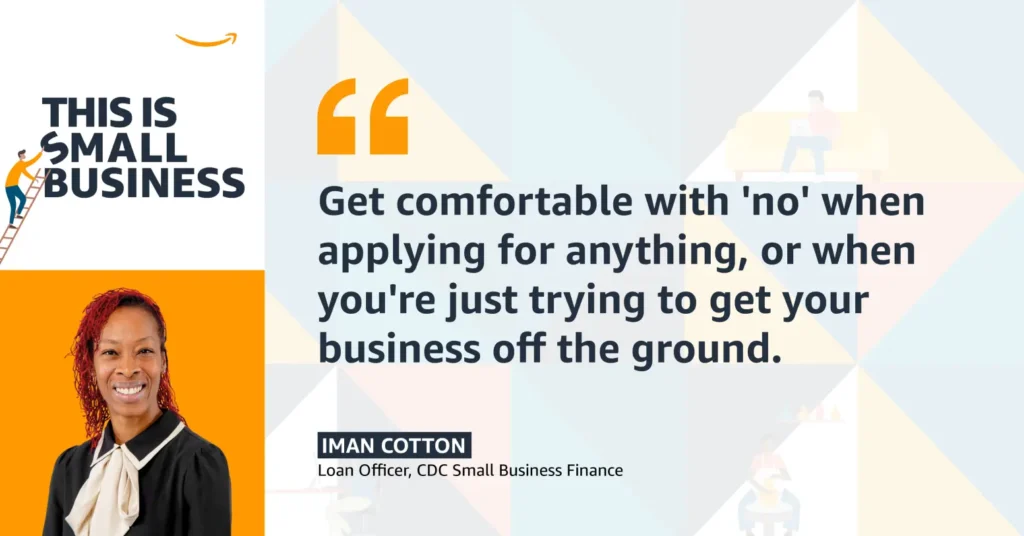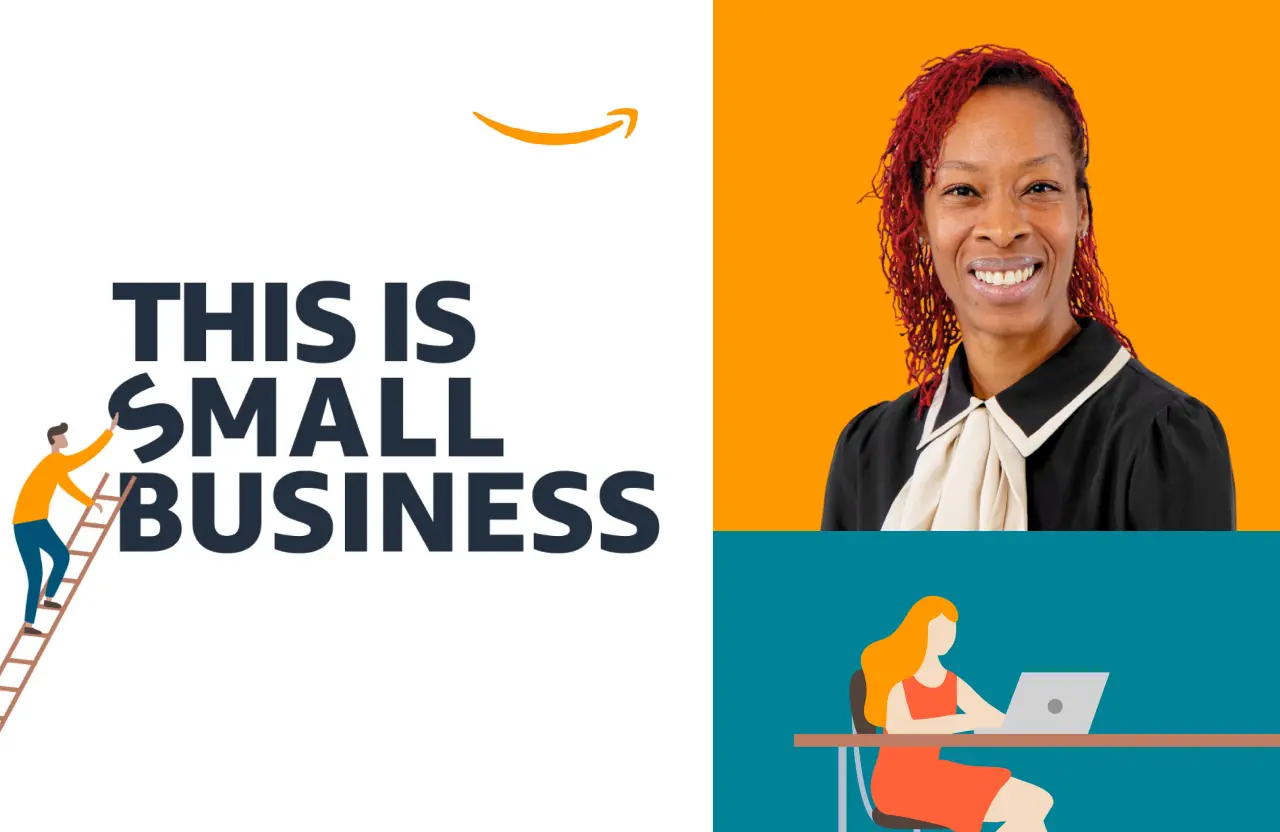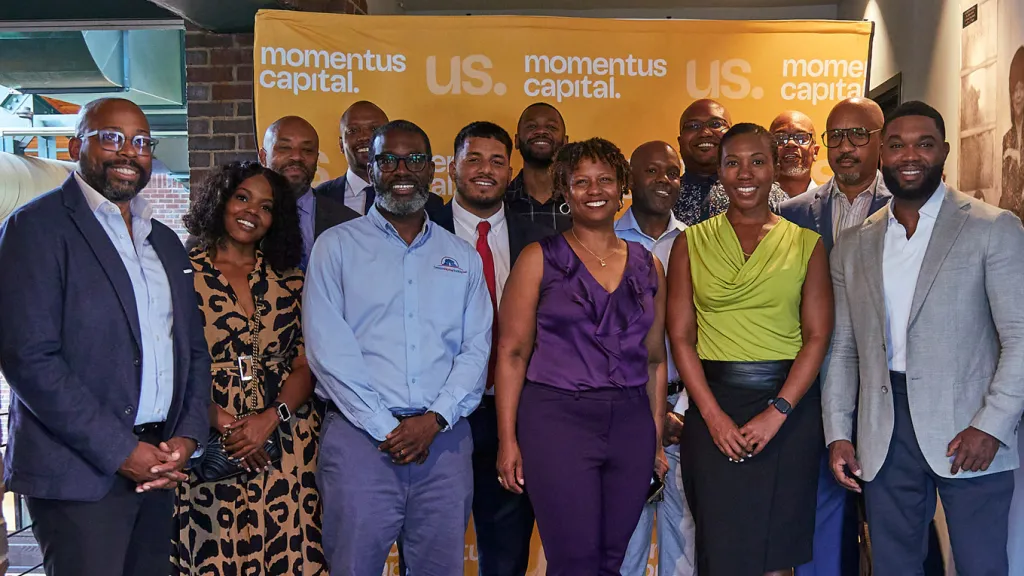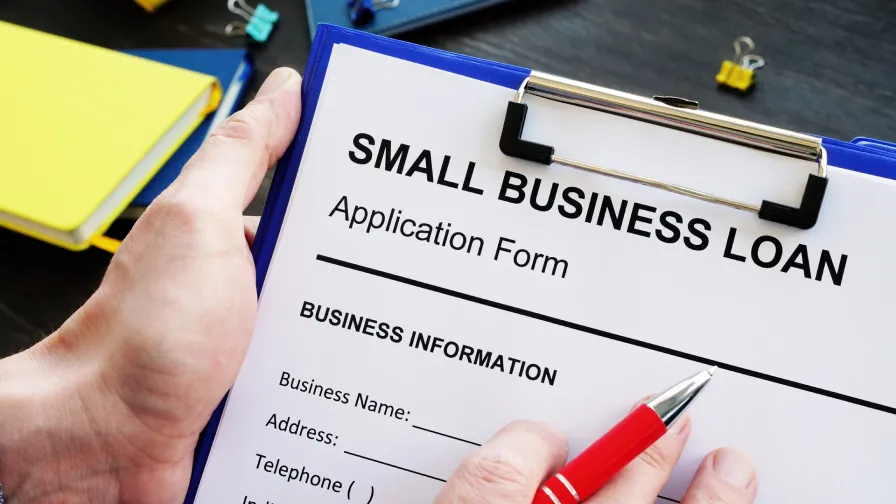For entrepreneurs and small businesses, the quest for financial stability is a constant. Money fuels the engine of business, from inception to expansion and beyond. Yet for many, the realm of business loans remains shrouded in mystery and anxiety.
Recently, CDC Small Business Finance’s very own loan expert, Iman Cotton, sat down with Andrea Marquez on her “This is Small Business” podcast presented by Amazon. Together, they delved into the intricacies of securing business loans and demystified the process. Iman went on to explain how to navigate the labyrinth of loan options, illuminated red flags to be mindful of, and offered indispensable insights to help entrepreneurs confidently steer their journey.
Listen to the podcast here. It can be found on Amazon Prime, Apple Podcasts, Spotify, and Google Podcasts.

The following is a transcript of the episode, “Business Loans Dos and Don’ts” from the This Is Small Business podcast.
Andrea Marquez:
Money is always top of mind for an entrepreneur. You need it to be able to start, grow, pay yourself, your employees. The list goes on and on and on. And one way to fund your business is through loans.
I don’t know if you feel like this, but to me, loans are super scary. I’ve always been told to never spend money I don’t have. Like, what will happen if I miss a payment? How can I make sure I’ll be able to pay it on time? Where do I even apply for loans? How do I find out if I qualify? If you’ve never applied for a loan before, it can feel like a daunting process. So, let’s break it down together.I’m Andrea Marquez, and This is Small Business, a podcast brought to you by Amazon. Today, we’ll be talking about business loans.
Iman Cotton:
Each financial institution has credit enhancement products such as loans, government guaranteed loans, state guaranteed loans. They even also have lines of credits and possibly more products. Then there’s nontraditional lending organizations such as a certified development company, or a CDC, and they are created to help business owners access capital. There’s also a community development financial institution who provides access to affordable financial products and services in underserved communities.
Andrea Marquez:
That’s Iman Cotton. She’s a loan officer with CDC Small Business Finance. And before that, she worked in banking with loads of traditional institutions. Iman just listed a bunch of different options that are available to small business owners. But before you start applying for a loan, first, you need to figure out who’s going to be your lender.
Iman Cotton:
Start with your deposit relationship or start with your actual bank loan. So, I’m huge on relationships and I love relationships because I love the guidance and I want to work with like-minded individuals and people who believe in me and will champion whatever it is that I’m doing. So, who’s your deposit relationship with? Also, you want to explore and research, like the SBA district office in your area. And then there’s other resource partners, such as the SBDC and SCORE. They can help with business plans, with different resources with different lending partners.
Andrea Marquez:
And there’s a few red flags to keep in mind while you’re trying to find a lender.
Iman Cotton:
You want to ensure that they’re an actual lender. So, for example, there’s a merchant cash advance, or MCA. This is not a loan. This is an advance on your receivables that you’re able to secure in the event you accept debit and credit card payments. But again, an MCA is not a loan, it’s an advance on your future receivables, where you pay back a percentage of your daily sales as the repayment.
Andrea Marquez:
And you’ve heard this one before, but…
Iman Cotton:
Something that sounds too good to be true, it probably is. [laughter] So, those loans that you can get approved in days, or its low-doc or no-doc or quick documents. You want to be leery of those because you may have an extremely high annual percentage rate, or APR. And then also if they can’t disclose the APR or the annual percentage rate, be leery.
Andrea Marquez:
Honestly, I apply that to all of my life. If it sounds too good to be true, it probably is. So, when you’ve done your research and figured out what loan and lender works best for you, you may be ready to apply. Let’s get into what documents you’ll need.
Iman Cotton:
If you’re a startup business, you want to ensure that you have a business plan and financial projections. We want to see that you have your personal tax return completed for the current year. If you’re an existing business, you want to ensure that you have your current personal and business tax returns completed and that they’re current and accurate. We want to see that you also have interim financial statements such as an interim profit and loss statement and an interim balance sheet.Being aware of your current debt load and cash position is extremely important. That way we can have an intelligent conversation, and I can help possibly quarterback the situation to make suggestions or recommendations how to better prepare yourself in the event that I don’t have a solution for you today. If the answer is “no” today, how can we turn that “no” into a “yes,” or what’s the actual game plan?
Andrea Marquez:
Now let’s get into what you should avoid doing when you want to apply for a small business loan.
The first is, don’t spend money until you know you can finance the whole cost.
Iman Cotton:
So, for instance, if you have construction or tenant improvements that you need for a new location that you’re looking to lease, or to have your business run out of, if the construction is $200,000 and then it happens to increase to $250,000, if you’ve already started that project and the project increases, you might run the chance where you can’t receive financing because some lenders may not go into a project that started to finance it.
Andrea Marquez:
The second mistake is not getting help when you need it.
Iman Cotton:
We have a lot of clients that have to get amendments because of their tax returns just being completely erroneous because they tried to do them themselves.
Andrea Marquez:
The third mistake is running too many personal expenses to reduce taxable income. Iman says this is the biggest mistake small business owners tend to make.
Iman Cotton:
For instance, if your revenue is $10 million a year and you want to apply for a loan, but you write all of your expenses off to where now your net profit or net income is negative $2 million, We look at the negative $2 million versus the $10 million in revenue. So, we more-so care about profit and net income versus the revenue amount. So be cautious to not write all of your revenue off to reduce your taxable income.
Andrea Marquez:
The fourth mistake is taking more money than you actually need.
Iman Cotton:
It can ultimately put you in a tight cash flow situation, but we do our due diligence to ensure that we are not putting our clients in a worse off situation and that they can actually afford what they’re actually requesting and the use of funds is a legitimate use of funds. So, within requesting money, what you say you’ll use the money for, you have to use the money for that. We’re not financing money for you to personally live off of. Keep that in mind. This is strictly for the business, and you want to get exactly what you need.
Andrea Marquez:
And to make sure you can actually pay back the money you’re borrowing; Iman says that you need to have a business plan and 24 months of financial projections.
Iman Cotton:
You’re sitting down setting the road map of what you anticipate your sales to be, what you anticipate your cost of goods, the expenses, the payroll, just the overall operating expenses so you can actually arrive at the net profit that you want to. So, it’s kind of like backing into the numbers. And creating that road map so you can have a plan to go off of to generate the amount of revenue that you need to pay back the loan and to cover all of your expenses.
Andrea Marquez:
Let’s say you finally got the loan. Congrats! Now you need to make sure you keep up with those payments because there are consequences to not being able to pay back your loan. But if things don’t go the way you planned, Iman says that you need to be transparent with your lender so that they can help you get through it.
Iman Cotton:
The goal is not for our borrowers to default on the loan. So, it’s just about being transparent and communicating and trying to set in place a workout plan and going from there. Assuming they can’t pay back because the business is closing, then the lender would come in to liquidate the assets and work with the borrower to work out any remaining balances. And then they may look at any personal collateral if it was held and things of that nature. But ultimately, one can lose their business and not be eligible for any additional federal lending if they aren’t able to pay back the loan.
Andrea Marquez:
That was a lot of information on how you can secure a loan. Iman did a great job of simplifying the process, but all this information can get a little bit overwhelming. So, if you’re still unsure about whether a loan is the best option for you…
Iman Cotton:
Don’t be fearful to at least have conversations now about what goals you have for your business. I always say, don’t call me after you’ve quit your job. [laughter] Call me before you leave that place of employment.
Get comfortable with “no” when applying for anything, or when you’re just trying to get your business off the ground. The more you hear “no,” the more you can also hear “yes.”
Andrea Marquez:
That was Iman Cotton, a loan officer. Getting comfortable with hearing “no” is a great piece of advice to end on. As an entrepreneur, you might be hearing it a lot.
I hope this episode helped make loans a little less scary. Let me know how you’re getting prepared to find or apply for a loan, or if there’s any advice that stood out to you. We covered a lot in this episode. So, if you missed anything, don’t worry. We’ve taken notes for you. You can find them at smallbusiness.amazon/podcasts.
That’s it for this episode of This Is Small Business brought to you by Amazon. If you like what you heard, make sure to subscribe and tell your friends about it by sending them a link to this episode. And we would love to know what you think. So, please, please, please leave us a review on Apple Podcasts. It’s easiest to do on your phone. Or leave us an email at thisissmallbusiness@amazon.com with your thoughts. Until next time This Is Small Business. I’m your host, Andrea Marquez. Hasta luego and thanks for listening.





